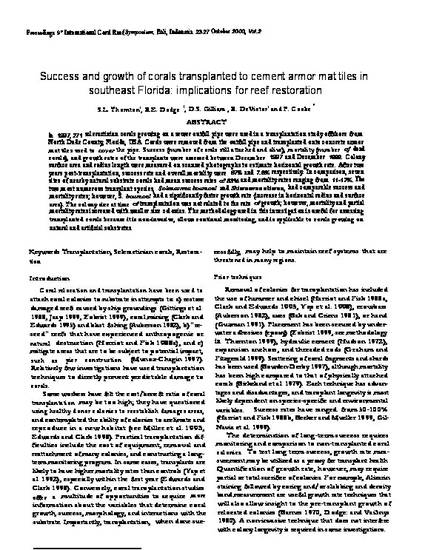
- Transplantation,
- Scleractinian Corals,
- Restoration,
- ICRS9,
- Armor Mat Tiles
In 1997, 271 scleractinian corals growing on a sewer outfall pipe were used in a transplantation study offshore from North Dade County, Florida, USA. Corals were removed from the outfall pipe and transplanted onto concrete armor mat tiles used to cover the pipe. Success (number of corals still attached and alive), mortality (number of dead corals), and growth rates of the transplants were assessed between December 1997 and December 1999. Colony surface area and radius length were measured on scanned photographs to estimate horizontal growth rate. After two years post-transplantation, success rate and overall mortality were 87% and 7.8% respectively. In comparison, seven sites of nearby natural substrate corals had mean success rates of 83% and mortality rates ranging from 11-17%. The two most numerous transplant species, Solenastrea bournoniand Siderastrea siderea, had comparable success and mortality rates; however, S. bournoni had a significantly faster growth rate (increase in horizontal radius and surface area). The colony size at time of transplantation was not related to the rate of growth; however, mortality and partial mortality rates increased with smaller size colonies. The methodology used in this investigation is useful for assessing transplanted corals because it is non-invasive, allows continual monitoring, and is applicable to corals growing on natural and artificial substrates.
In Moosa, M.K., S. Soemodihardjo, A. Soegiarto, K. Romimohtarto, A. Nontji, Soekarno and Suharsono (ed.). Proceedings of the Ninth International Coral Reef Symposium, Bali. 23-27 Oct. 2000. Vol. 2: 955-962
Available at: http://works.bepress.com/richard-dodge/139/

Full conference proceedings may be found at http://www.reefbase.org